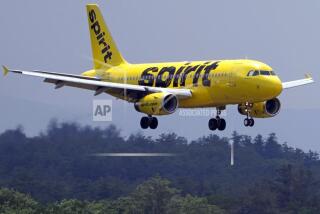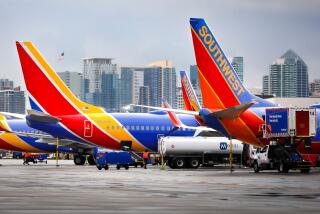One More Woe for Airlines
A stalled economy, terrorism fears and war in Iraq sent airlines into a tailspin. Now, official warnings for travelers to avoid Hong Kong and the next-door Chinese province of Guangdong are pushing passenger counts even lower. Major U.S. airlines not already in bankruptcy are using the threat of Chapter 11 to squeeze pay cuts from employees.
The industry is looking once again to the federal government for handouts. However, the last thing Congress should do in this environment is volunteer more than $3 billion in taxpayer funds to prop up failing airlines, as it is trying to do now. White House spokesman Ari Fleischer, who called House and Senate packages “excessive,” easily could have added “ineffective.”
Of course, economic recovery, a swift resolution to the war in Iraq and evidence that terrorist threats are under control worldwide would help airlines rebound. But airline executives also face structural problems that have dogged the industry since deregulation in 1978 -- runways jammed with too many planes, pricing that gouges their most dependable business travelers and failure to bring costs in line with revenue.
This isn’t just a cyclical downturn. Domestic carriers lost $10 billion in 2002. A worst-case estimate prepared before the lucrative Asian business travel market was battered by severe acute respiratory syndrome, or SARS, suggested an $11-billion loss this year. Total airline debt is more than $100 billion, and the value of the industry’s publicly traded shares has shrunk to less than $15 billion. U.S. airlines aren’t alone; Air Canada on Tuesday was forced into the Canadian equivalent of Bankruptcy Court.
Big airlines are cutting operating costs and capital spending by more than $10 billion, eliminating more than 90,000 positions, parking jets and dropping hundreds of daily flights. But it hasn’t been enough to keep pace with fuel price hikes, security costs and competition from low-cost smaller airlines.
President Clinton established a national commission in 1993 to explore ways to fix the airline industry, but even its mild recommendations, aimed mostly at the Federal Aviation Administration and Congress, were largely ignored. A decade later, airlines still don’t have business plans that can survive cyclical downturns or produce rational ticket prices.
Congress should work to preserve the nation’s transportation system, but start with acknowledgment that taxpayers -- already on the hook for $5 billion in direct cash aid and a $10-billion loan guarantee program -- can’t afford to keep every failing airline flying.
Bigger questions loom, including how regulators will respond if airlines propose blockbuster mergers. What if foreign carriers, barred from owning U.S. airlines, want to be part of the bidding? There is the omnipresent question of whether the 1978 airline deregulation is at fault. A one-size-fits-all attempt at re-regulation would risk harming successful post-deregulation start-ups, including Southwest Airlines and JetBlue. But nothing should be excluded from the debate.
More to Read
Inside the business of entertainment
The Wide Shot brings you news, analysis and insights on everything from streaming wars to production — and what it all means for the future.
You may occasionally receive promotional content from the Los Angeles Times.










